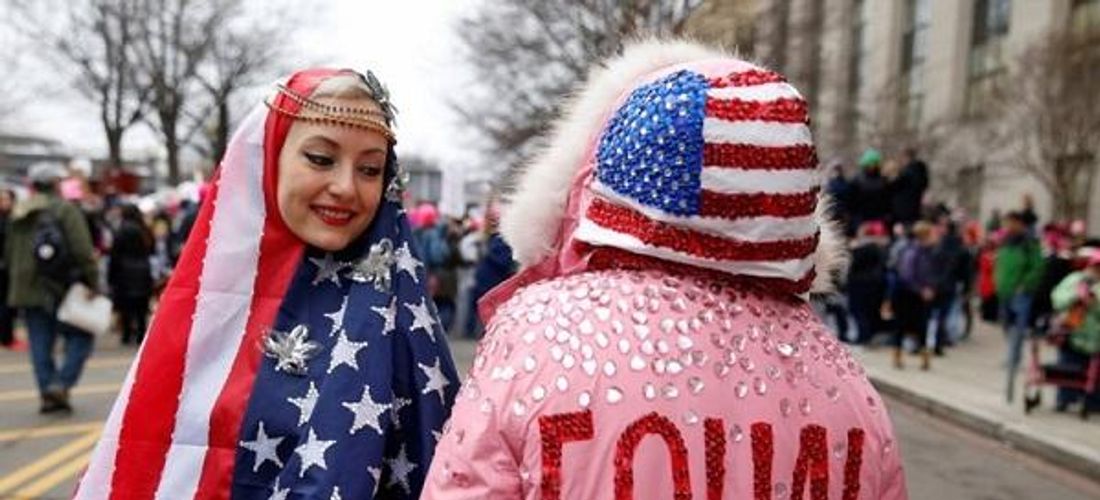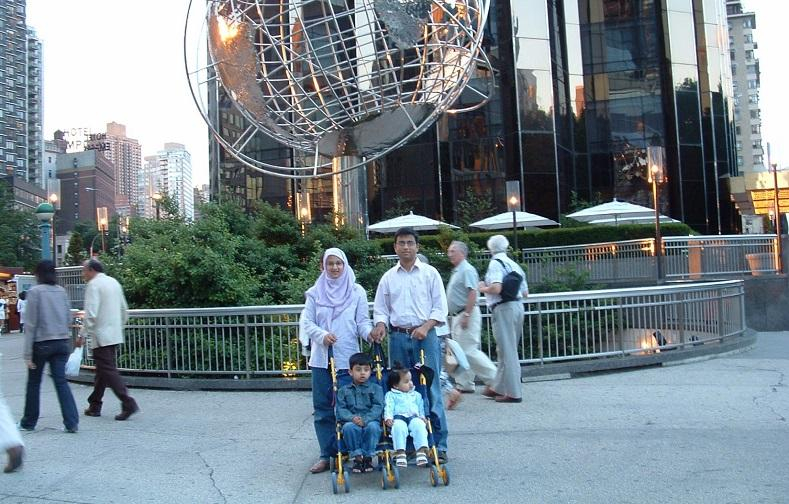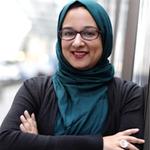Unapologetically Muslim – This is What America Looks Like
Current Events
|
Feb 17, 2020
|
4 MIN READ

Editorial note: This post is part of a site-wide discussion and campaign about "This is what America looks like," in which we are exploring the lives of powerful Muslim women, our activism and work and how we are standing up and showing up.
I hadn’t thought about this story for years, until one day some of my HH team members and I were talking about what it means and how it feels to be visibly Muslim heading into the 2020 presidential election cycle, versus how our communities felt back in 2016. You know, more so blindsided by the hate and fear whipped up by then-candidate Donald J. Trump and his base (unless you were Black and Muslim, by which case none of the hateful rhetoric, stereotyping or fear-mongering was new to you).
But our discussion brought this memory back, and it felt prescient to where we are now.

My husband, our then two kids and myself in Midtown Manhattan circa 2005, a few months after I started wearing hijab.
It was the spring of 2005, and I was in lower Manhattan around W. 17th Street, having snagged some quick street parking. I was walking towards my four-year-old’s school to pick him up. He was in his second year at the Association for Metro-Area Autistic Children (AMAC) school, and I was getting him so we could drive out of the city and upstate to a special private clinic where he received verbal behavior therapy.
I was a new hijabi of a few months, having begun wearing it after my husband and I had performed our Hajj pilgrimage in January of that year. I had never contemplated wearing hijab before I suddenly started to. It just felt right to me after Hajj. As I walked up the street to my son’s school, I passed a guy on a bicycle, who yelled at me:
“What the hell is wrong with you? You’re not what a woman is supposed to look like. You’re not what an American is supposed to look like! You should look like her!” He pointed towards a woman on the opposite side of the street dressed in a tank top and shorts, her hair flowing down her back.
I was taken aback for a second, shocked. Then I yelled back, “I’m totally what a woman can look like. This is America. I can dress anyway I want to!”
He gave me the finger. I decided it was better not to escalate the situation and hurried into my son’s school.
Fifteen years later, long after support and friendship extended to some pockets of Muslim communities in the immediate post-9/11 years faded, some things are a lot worse for Muslim women and Muslim communities in general. But in other ways, our eyes have been opened, and we’re more secure in our identity as Muslim, American and more.
When I think back to early spring of 2016 as the primaries and caucuses were gaining steam and Trump was beginning to flex his right-wing, anti-Muslim, anti-Latino, anti-minority, anti-immigrant muscles (while many Americans thought his election run was going to start and end as a joke), what remains clear to me from my coverage of Muslims in America is how too many of us were unprepared for what was to come.
Now as we head into the 2020 election season, we know that the Muslim Ban’s third iteration was just passed and upheld by the Supreme Court. The president’s ties and tweets in support of various White Supremacist ideologies have become part of his normal discourse, immigrant or asylum-seeking families have been brutally separated, Jewish cemeteries, synagogues and people have been targeted and desecrated, and many Muslims and other minorities have suffered from hateful attacks. Being Muslim, especially visibly so, is more precarious now than ever before. This is just the tip of the iceberg.

Haute Hijab Creative Director Gizelle Begler in her sparkly designed flag hijab at the 2017 Women's March in Washington, D.C.
The other thing different now is that our eyes are wide open. For some of us (like Black Muslims), they’ve been wide open for awhile. We know that the political (and anti-Muslim, anti-minority, anti-immigrant, etc) rhetoric will ramp up again in the coming months. But we are more ready for it. As I wrote in my “From the Editor’s Desk” column earlier this month:
Many have taken their fear and anger and channeled it into running for office and getting involved with politics, activism, community building and more. Others were doing that way before 2016.Here at Haute Hijab I've been thinking about how this cycle of being "otherized" and marginalized is not new for American Muslims or other minority communities. Black Americans and Black Muslim Americans (among others) have faced it for decades. As my writers and I discussed story ideas and themes for February (leading into the spring), we kept circling back to this idea that as Muslim women, none of is this is new for us. And, that many of us don't even realize the immense and deep history we have as being part of the American fabric.We stand on the shoulders of giants – women who forged paths, both wide and narrow, that we are walking on now. Teachers, mothers, professionals, activists, scientists and more who we may not even realize were doing the hard work of "living the resistance" long before that phrase become popular and heralded.We will be bringing you the stories of some of these women, young and old, upon whose shoulders we stand and those who are doing fantastic things now as part of our focus on "This is what America looks like."
We hope you tune into all our platforms at HH, as we explore our hard work as Muslim Americans through our stories about powerful Muslim women, the exploration of various important social justice topics and issues we are facing, the challenges we face and strength we derive from being (visibly) Muslim and more.
We will have a social media tie-in as well, with a focus on what helps us feel powerful as Muslim women in our work, our internal character and spirituality, demeanor and appearance. I know a lot of you have a go-to hijab that makes you feel powerful and strong – your power hijabs! We want you to tell us about that, so stay tuned to our Instagram and other social media channels to learn more!
We’re also going to talk about self-care and what uplifts us from within, about drawing strength from Allah (S), turning inward, and taking time to lean on Him and nurture our relationship with Him through prayer, dhikr and other acts of worship. Because we will need all of it to keep moving forward as strong Muslim women who are integral threads in the fabric of America.
So, stay tuned to the blog and all of our platforms at Haute Hijab. Come what may in the next several months, we are standing up, showing up. Because this is what America looks like.
Subscribe to be the first to know about new product releases, styling ideas and more.
What products are you interested in?

